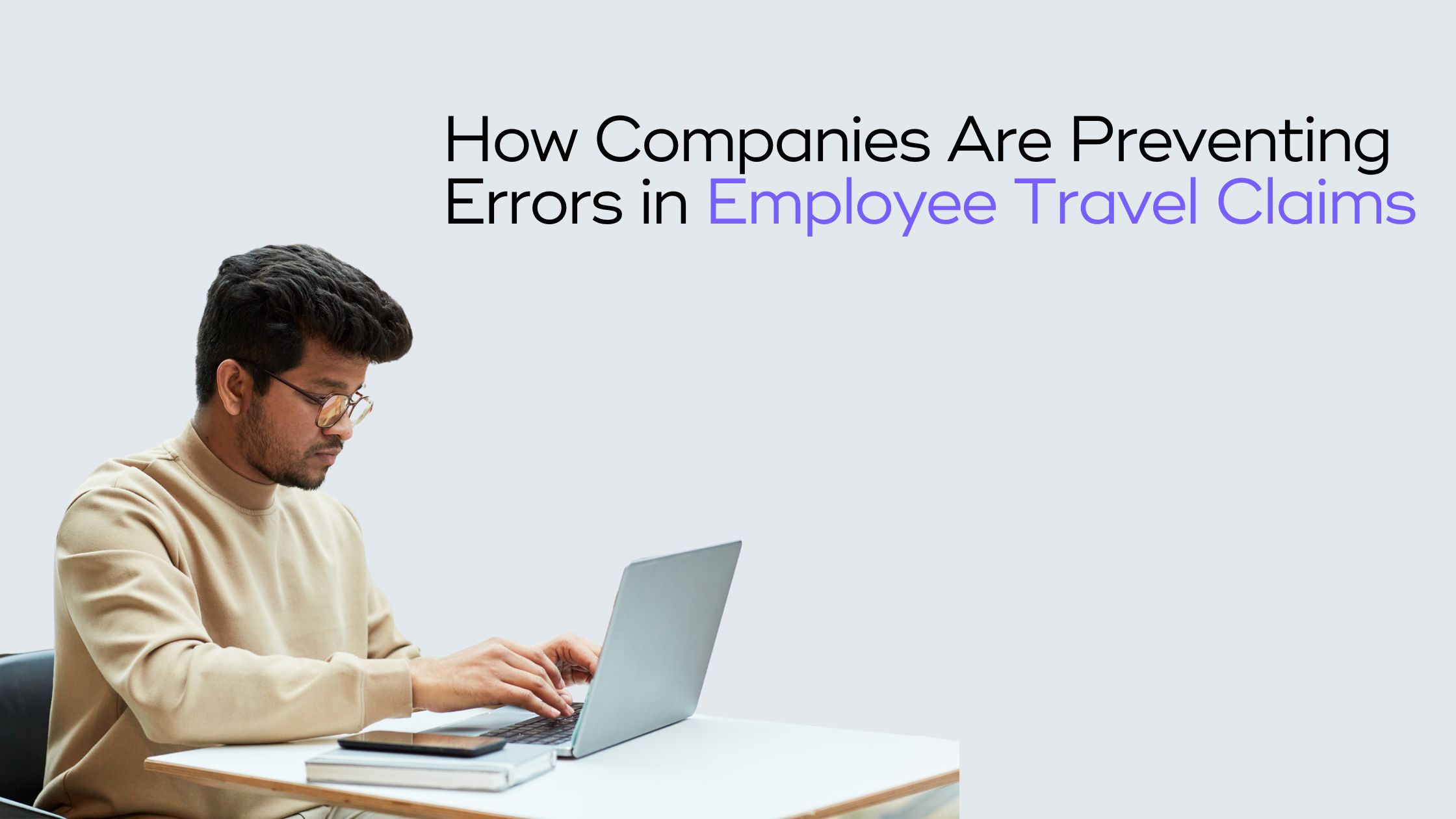Ever wondered why your inbox keeps filling up with unclear travel claims, missing bills, mismatched dates, or expenses that just don’t add up?
If you’re handling travel for your company whether as an HR, admin, or finance professional you’ve probably seen how tricky travel claims can get.
One wrong invoice, one missed bill, or one duplicate cab claim is all it takes to delay reimbursements and disrupt workflows.
And when it keeps happening again and again, it doesn’t just affect finance, it affects your time, your team’s trust, and your overall travel system.
Many companies are already solving this problem. And you can too without adding extra steps to your already busy day.
Let’s explore why incorrect travel claims happen, and how you can prevent them with simple, smart solutions.
Why Do Incorrect Travel Claims Keep Happening?
Before jumping into solutions, it’s important to understand the common reasons travel claims go wrong. And more often than not, they aren’t intentional.
These errors usually happen because the process is too manual, scattered across platforms, or simply unclear to employees.
Here’s where things go off track:
- Manual expense entries make it easy for employees to miscalculate, forget past claims, or submit the same receipts twice especially when tracking is done over spreadsheets or email.
- Lack of real-time data means you’re often left guessing whether a cab ride actually happened or a hotel stay was within policy, unless you manually check with vendors or scroll through bookings.
- Lost or incomplete invoices are common. Employees may forget to attach bills, upload screenshots instead of GST invoices, or send documents days later holding up the entire process.
- Confusion around policies leads to unintentional violations. Some team members may not know what’s allowed and may claim personal rides, food bills, or luxury hotel upgrades, assuming they’re covered.
- Last-minute travel changes, such as cancellations, rebookings, or itinerary shifts, often lead to mismatches between actual travel and claimed expenses.
If any of these sound familiar, you’re not alone. These are some of the most common frustrations companies face when managing business travel but they are fixable.
So, How Are Companies Solving It?
The solution doesn’t lie in adding more checks or more manual review.
Leading companies are simplifying the system by using smarter tools, centralised control, and automation making life easier for both employees and the HR/finance teams.
Let’s look at how they’re doing it:
1. Centralised Travel Booking Systems
The first major shift is moving away from scattered booking methods. Instead of letting employees book from various platforms or apps, companies are now using centralized corporate travel systems like CoTrav.
When all travel whether it’s flights, hotels, or cabs is booked through a single platform, the travel trail becomes clear and traceable. Every booking is auto-recorded with exact dates, vendor details, and costs. There’s no room for doubt.
What this means for you is simple: you don’t have to chase down confirmation emails or manually track which trip happened when.
You get full visibility of every trip in one place, no digging through inboxes required.
2. Automated Matching of Claims with Actual Usage
Another powerful solution companies are using is automated expense verification. Instead of relying on manual checks, smart platforms now auto-match the claimed expense with the actual trip record.
For example, if an employee claims a cab fare:
- The system verifies if the ride happened.
- It checks if the claimed amount matches the invoice.
- Any mismatch in distance, amount, or timing is flagged instantly.
As an HR or finance approver, this removes the need to second-guess employees or go line-by-line through each bill. The system takes care of the accuracy, leaving you with just the final review.
3. Real-Time Invoice & GST Compliance
Fetching proper invoices, especially GST-compliant ones is a major challenge for many teams. Employees may forget, delay, or upload incomplete documents, leaving you scrambling during audits.
To solve this, companies are now using travel platforms that fetch invoices directly from the vendor instead of relying on the employee.
These invoices are:
- GST-ready
- Time-stamped
- Linked automatically to the relevant trip
For you, this means no follow-ups, no reminders, and no worries about compliance. Everything’s already in place.
4. Built-in Travel Policy Controls
Even with a solid travel policy, enforcing it manually can be a headache. That’s why many companies are now using tools where the travel policy is built directly into the system.
If someone tries to book a business-class ticket, select a hotel outside the allowed budget, or submit a personal ride the system either flags it or blocks it completely, before the error is even made.
This kind of pre-checking ensures that only valid, policy-compliant claims reach your desk — saving you from those awkward “this isn’t allowed” emails.
5. Educating Employees Without Overloading Them
Technology can solve most of the problem but a little clarity still goes a long way.
To reduce confusion, many HR teams are taking a proactive approach:
- Including travel policy highlights during onboarding
- Sharing simple “Do’s and Don’ts” for claims
- Sending quick reminders via WhatsApp, Slack, or email
- Creating a mini travel FAQ for employees
When your team knows what’s allowed and how to claim it, they’re less likely to make mistakes and you’re less likely to chase them for corrections.
How CoTrav Helps You Manage This Seamlessly
If you’re looking for a way to simplify travel claims and bring all bookings under one system, CoTrav is designed with that exact goal in mind.
With CoTrav, you get:
- A single dashboard to track all cab, hotel, and flight bookings
- Automated prevention of duplicate or out-of-policy claims
- GST-compliant invoices fetched directly from vendors
- Real-time reports on pending and approved claims
- A full audit trail for every employee trip
There’s no need to remind employees about bills or worry about verifying ride details. The system does it for you accurately, automatically, and in real time.
Conclusion
Managing incorrect travel claims isn’t just about correcting errors, it’s about preventing them from happening in the first place.
And you don’t need more manpower or stricter rules to do it. You just need a smarter system that supports you at every step from the moment a trip is booked to the second the claim is approved.
With the right tools in place, you can:
- Save valuable time
- Ensure better policy compliance
- Speed up reimbursements
- Build a smooth, transparent, and trust-driven travel experience for everyone
As someone already balancing so many responsibilities, you deserve a travel process that works with you, not against you.
Let smart platforms like CoTrav handle the heavy lifting so you can focus on what truly matters.
FAQs
Q1. Why do incorrect travel claims happen?
Incorrect claims usually come from manual entries, lost receipts, or confusion around what’s reimbursable. Without a proper system, it’s easy for errors to slip in.
Q2. How can we make travel claims easier for employees?
Provide a clear travel policy, explain allowed expenses, and use a unified platform where bookings, invoices, and claims are connected from the start.
Q3. What’s the best way to verify travel claims?
The best way is to automate verification. Platforms like CoTrav auto-match claims with actual bookings, dates, and vendor invoices to ensure accuracy.
Q4. Can automation reduce claim errors?
Absolutely. Automation removes guesswork, flags policy violations in real-time, and ensures that claims are based on real, verified data.
Q5. How does CoTrav help HR with travel claims?
CoTrav tracks every booking, auto-generates GST invoices, and keeps all claim-related data in one place making approvals smoother and faster for you.




